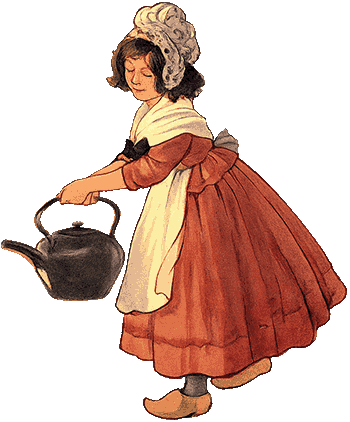Polly, Put the Kettle On
Polly, put the kettle on,
Polly, put the kettle on,
Polly, put the kettle on,
We'll all have tea.
Sukey, take it off again,
Sukey, take it off again,
Sukey, take it off again,
They're all gone away.

Origins
The rhyme first turned up in print in the early 1800s, though it was already being sung before that. A London publisher, Joseph Dale, printed it in 1803 under the title Molly Put the Kettle On or Jenny’s Baubie. Around the same time, a Dublin edition used “Polly” instead of “Molly,” and by the mid-19th century the “Polly” form had stuck. Dickens even quoted it in Barnaby Rudge in 1841, showing how widely known it was by then.
The tune itself may be older still. A melody called Jenny’s Baubie was printed in the 1770s and seems to have been borrowed for the rhyme. Some music historians hear echoes of continental tunes like O du lieber Augustin. Whatever its roots, the music gave the rhyme legs — it was easy to sing and stuck in the ear.
Meaning
This rhyme is about as straightforward as they come. Someone shouts for Polly to put the kettle on, and before the tea can even be poured, Sukey is told to take it off again because everyone’s gone home. It’s the smallest story — but that’s what makes it fun. Kids loved the repetition, the sense of bustle, and the sudden twist: tea’s off!
Cultural Background
By the time this rhyme was making the rounds, tea wasn’t just a drink — it was a ritual. The kettle went on for visitors, for family talks, for moments of rest. Children saw this every day and, naturally, turned it into a game. One child would play “Polly,” carefully pretending to put the kettle on, while another played “Sukey,” swooping in to spoil the fun by taking it off again. The back-and-forth of the rhyme matched the back-and-forth of play, equal parts mischief and make-believe.
 When Victorian artists illustrated the verse, they filled it with familiar details: a cottage hearth glowing, steam curling from a kettle, children in simple clothes laughing at the game. Nothing grand, nothing strange — just the texture of ordinary life, caught in a rhyme that children could chant while they played. That everyday grounding is exactly what made it so beloved.
When Victorian artists illustrated the verse, they filled it with familiar details: a cottage hearth glowing, steam curling from a kettle, children in simple clothes laughing at the game. Nothing grand, nothing strange — just the texture of ordinary life, caught in a rhyme that children could chant while they played. That everyday grounding is exactly what made it so beloved.